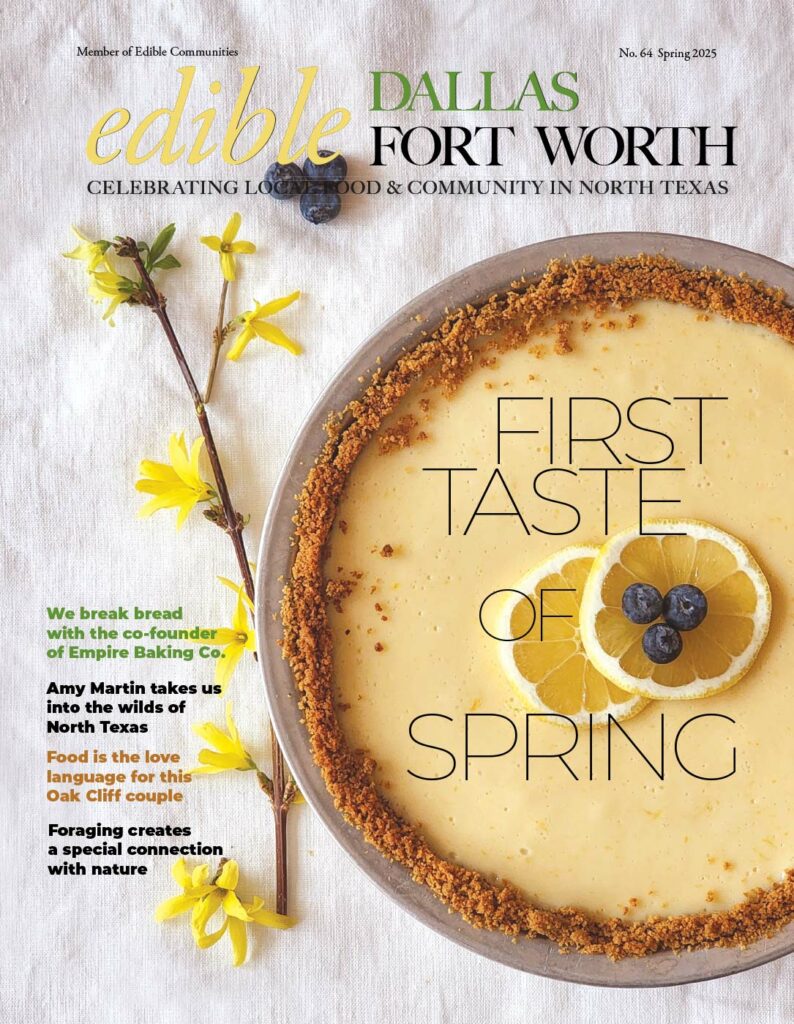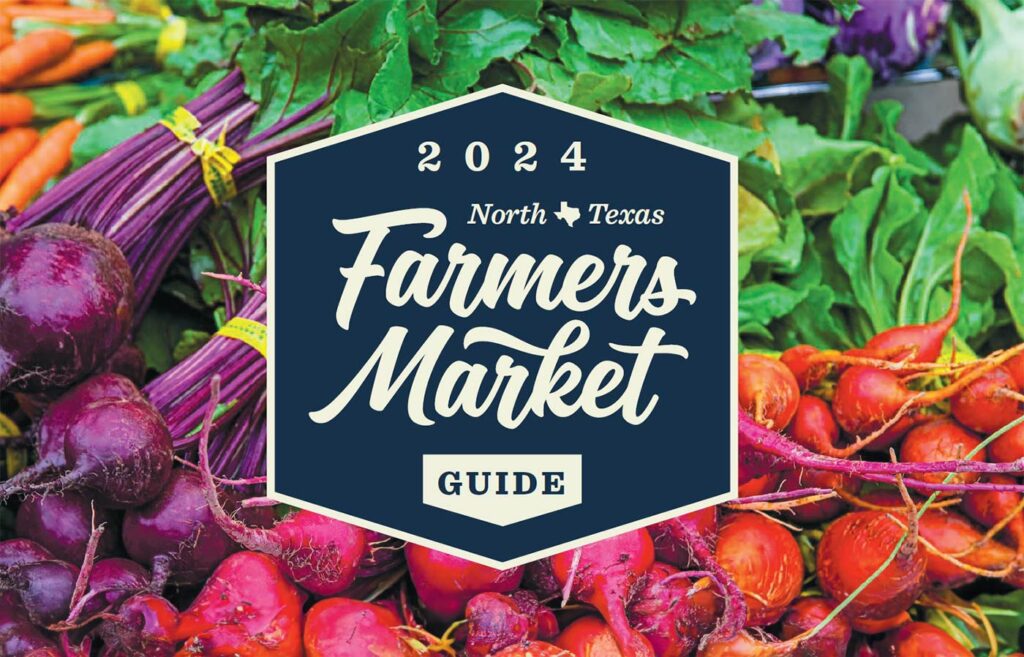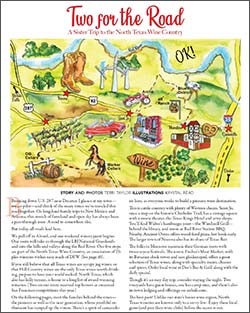The State of Texas’ Olive Oil Industry
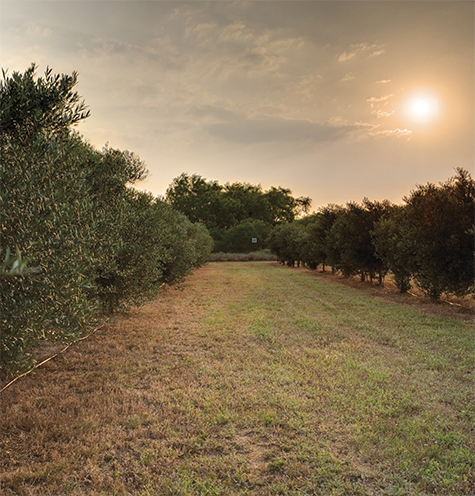 Sunset at Farrell’s Olive Orchard in Artesia Wells.
Sunset at Farrell’s Olive Orchard in Artesia Wells.
Jerry Farrell and wife Penny are also shareholders
in Texas Olive Ranch photo by Matthew Chase
“Everyone said, ‘You can’t
grow olives in Texas.”
— Jim Henry, father of the Texas olive oil industry
Ten years ago, you couldn’t buy Texas olive oil. Now, Texas olive oil production is a viable industry poised to take off, thanks to a few intrepid Texans, including Jim Henry, the state’s first commercial producer whose efforts primarily yield extra-virgin olive oil (EVOO), and Saundra “Sandy” Winokur, owner of Sandy Oaks Olive Orchard, who has a holistic, diversified approach. They represent two kinds of olive production within the state.
TEXAS OLIVE RANCH
“Everyone said, ‘You can’t grow olives in Texas,’” says Dallas native Henry, a founding director of the Texas Olive Oil Council known as the father of the Texas olive oil industry. He saw similarities between the climates of South Texas and Spain, the world’s largest olive producer, and asked, “Why not?”
He planted trees. His first orchard—10 acres in Marble Falls in the Texas Hill Country—died, lost to the cold. He planted again, further south. Those trees froze, too. Then, Henry heard about some 50-to-60-year-old olive trees in South Texas. “Now we’re getting somewhere,” he says.
His pioneering experiments, coupled with a handful of other growers’ efforts, eventually would prove fruitful. When Henry’s first bumper crop yielded enough oil to sell in 2007, he had ready buyers. Now, at 10 years old, Texas Olive Ranch, Henry’s 67-acre orchard near Carrizo Springs north of Laredo, is the oldest and most productive olive orchard in Texas. The olives from its 40,000 trees are pressed into EVOO and sold under the Texas Olive Ranch brand with its distinctive cowgirl label at Whole Foods Market, HEB grocery stores, specialty shops and farmers markets.
Yet, Henry says the orchard is not in the optimal place. “Growing olives in Texas is strictly related to the weather,” says Henry, who has determined that the only areas within the state where olive orchards thrive are south of San Antonio and along the Gulf Coast. Henry believes the perfect location for growing olives is Victoria, between Corpus Christi and Houston. He originally planted 70,000 trees there last year, doubled that number and sold the orchard to Turkish investors. It, too, is called Texas Olive Ranch and, as a business partner, Henry manages and oversees the ranch, now Texas’ largest olive oil production facility.
Henry’s goal is to produce quality olive oil profitably and to educate people about what constitutes quality. Now that he has proven he can grow olives in Texas, the trick will be to produce commercially on a large scale. “It’s so hard to make money in a small farming operation. People don’t understand what hard work it is,” Henry says.
Most of the Carrizo Springs ranch plantings are Arbequina trees, which do well in the sandy loam soil of the Middle Rio Grande Valley, whose climate is similar to that of southern Spain where the tree originated and where the bulk of the world’s olive oil is produced. Two additional varietals—Arbosana, whose origins are Spanish, and Koroneiki, from Greece—were added for cross-pollination. The Arbequina trees have not only proven reliable, but also produce oil with a smooth buttery profile that American palates prefer. “Our olive oil is comparable to the best oils in California and Europe,” Henry says. “Olive oil is a fruit juice.” Like freshly squeezed orange juice, “the fresher it is, the better it is.”
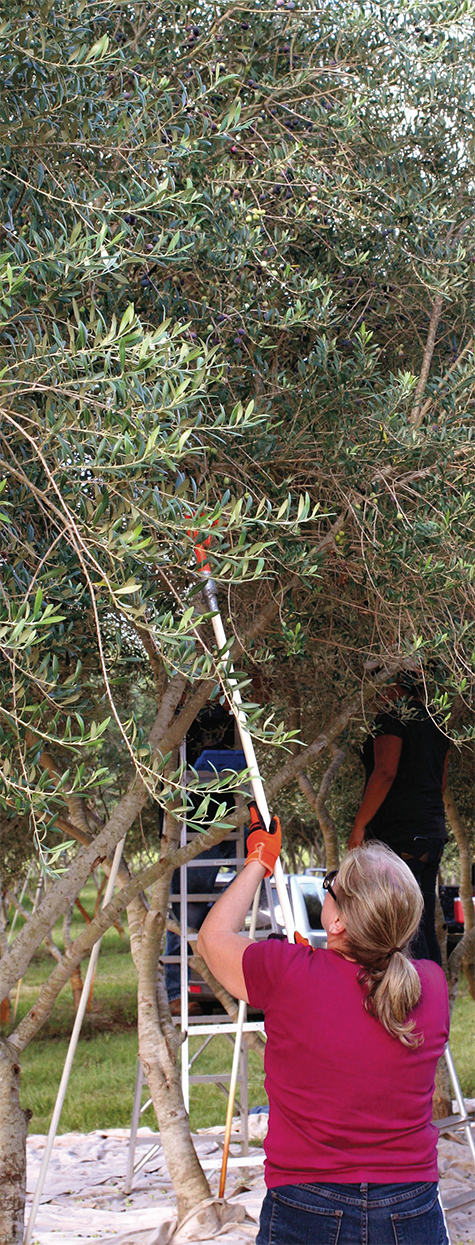 Hand harvesting olives at Sandy Oaks Olive Orchard in Elmendorf.
Hand harvesting olives at Sandy Oaks Olive Orchard in Elmendorf.
photo Courtesy of Sandy Oaks Olive Orchard
Americans consume some 25 percent of the world’s olive oil, but account for only about 2 percent of production, according to University of California at Davis, Henry says. Americans largely rely on imported olive oil from Europe, whose quality is not guaranteed. Chances are most consumers have not experienced fresh olive oil and their reference may be olive oil that tastes and smells rancid.
In the U.S., “a lot of bad olive oil [is] being sold,” says Henry’s wife, Karen Lee Henry, managing director for the Texas Olive Oil Council. “The entire country is just beginning to understand what fresh olive oil tastes like. The Mediterranean Diet has been driving the U.S. market, but there’s nothing that says you should be getting fresh, locally produced olive oil.”
Until recently, inadequate labeling of olive oil’s age, origin and purity has been a factor, according to a spring 2015 ezine article published by the Texas Olive Oil Council. Reforms are underway in Europe whose olive oil industry has been inundated by fraud and poor practices, and last September, the California Department of Food and Agriculture mandated stricter testing procedures and new labeling requirements. California set the precedent, and Texas olive oil producers, including the Henrys, are behind such measures.
“I testified, along with other growers mostly from California, in front of the U.S. Trade Commission,” says Jim Henry, who also appeared before the Texas and California Departments of Agriculture.
“All we were asking was to require importers to tell the truth on their olive oil labels—where it’s from, when it was bottled, and is it extra virgin.” Labels protect the consumer, he says, and although the commission wrote a brief in the olive industry’s favor, there’s no one to enforce it, he says. “All we can do is educate the American consumer. I encourage people know their growers, visit their orchards and see for themselves.”
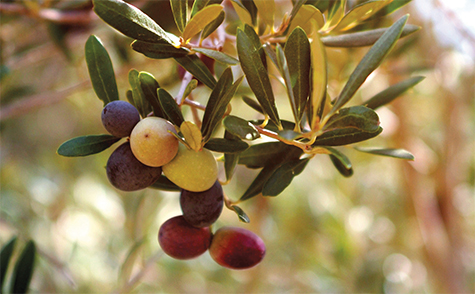 Arbequina olives photo Courtesy of Sandy Oaks Olive Orchard
Arbequina olives photo Courtesy of Sandy Oaks Olive Orchard
As the country’s No. 2 producer behind California, Texas is positioned to become No. 1 within 10 to 15 years, according to Karen Lee Henry. California has had to scale back its well-established industry because of continuing drought, she says. “We have a lot of available land, water and labor in Texas. As the U.S. industry becomes more and more demanding for domestic olive oil, traditional growers overseas are looking at Texas as the sweet spot to do it.”
While the bulk of his production ends in EVOO, Henry sells fresh, handpicked olives in bulk to a few Austin-area chefs, who cure the olives themselves. “I want table olives and raw olives for sale,” says Henry. “I want different taste profiles with different varietals. I want to go in a different direction.”
SANDY OAKS OLIVE ORCHARD
Texas native Saundra “Sandy” Winokur takes a more artisan path. She has tested 38 olive tree varieties from many parts of the world, including France, Greece, Italy, Spain and Tunisia, on Sandy Oaks Olive Orchard, a 40-acre tract with 11,000 olive trees on her 267- acre ranch in Elmendorf south of San Antonio.
“I love to do research,” she says, attributing her passion to her education in experimental psychology. “I thought it would be of interest and helpful to find out what grows in Texas.”
Winokur has tried multiple grids for spacing olive trees. Rather than applying the super-high-density planting approach that Henry uses, which requires modern machinery for harvesting, Winokur grows crops in the traditional style that allows for more space between trees. The olives must be handpicked because the orchard’s sandy soil doesn’t allow for large, heavy equipment; however, Winokur eventually plans to employ a modified, tractor-mounted branch shaker that will fit between the rows.
“I encourage people to know their
growers, visit their orchards
and see for themselves.”
— Jim Henry
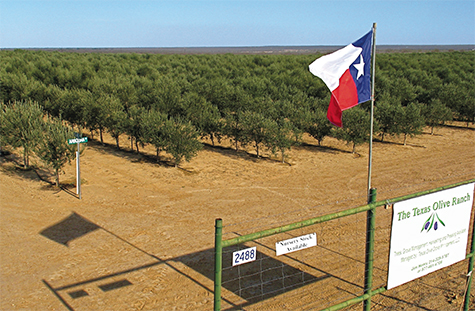 photo: Karen Lee Henry
photo: Karen Lee Henry
“It’s a bountiful tree,” says Winokur, who follows the ancient model of using its every aspect. In addition to EVOO, she makes olive-oil-based merchandise, such as pantry items (e.g., table olives, olive leaf tea and jelly, and olive almond brittle) and all-natural, non-toxic spa and skincare products. Visitors may also dine at Sandy Oaks’ farm-to-table café that heavily leans on recipes using olive oil.
Education is part of Sandy Oak’s mission. Winokur offers once-aweek tours to visitors and assistance to small orchard growers, purchasing olives from them and giving attribution on the EVOO’s bottle label.
“There’s more demand for my products than I can supply,” says Winokur who has no interest in expanding her operation. Winokur and her staff of up to 17 employees have their hand in all aspects of the working farm, and nearly all aspects of the business are managed on site. “We try to keep it small so we can control the quality,” Winokur says.
GOING FORWARD
“The industry [is] moving in so many different directions,” Winokur says. “There are so many niches and so many different ways of planting.” Texas growers who produce on a smaller scale include:
- Jack and Patricia Dougherty planted an olive orchard in Wimberley around the same time as Henry and Winokur. In addition to producing First Texas Olive Company brand olive oil, their Bella Vista Ranch is home to grapevines and a winery, and they offer tours.
- Curtis Mickan and grandson Josh Swafford own Central Texas Olive Ranch in Granger, northeast of Austin, on land family-owned since the 1870s. Theirs is Texas’ second-largest mature olive ranch, growing 23,000 trees on 33 acres.
- The Texas Hill Country Olive Company owned by John Gambini spans 17 acres in Dripping Springs and offers award-winning olive oils, balsamic vinegars and spa products.
“We are just starting this industry,” Jim Henry says. “It has huge potential, if we can figure out where to plant and how to incorporate modern technology and modern farming techniques. Real opportunities are in what we can do going forward.
“What the future offers—that’s what’s exciting.”
ELLEN RITSCHER SACKETT loves to combine two of her passions, writing and food, and loves promoting other people's pursuits, which she accomplished as a writer/producer for the WFAA-TV show, Good Morning Texas, and as executive editor for Dallas and Houston Hotel Magazines. She occasionally contributes to The Dallas Morning News and was on the staff of its weekly entertainment magazine and digital team, dallasnews.com. In her spare time, Sackett cares for her many four-legged, furry and feathered family members and saves shelter dogs through Little Dog Rescue, which she founded. She invites you to follow her on Facebook.
- Ellen Ritscher Sacketthttps://www.edibledfw.com/author/esackett/
- Ellen Ritscher Sacketthttps://www.edibledfw.com/author/esackett/
- Ellen Ritscher Sacketthttps://www.edibledfw.com/author/esackett/
- Ellen Ritscher Sacketthttps://www.edibledfw.com/author/esackett/


